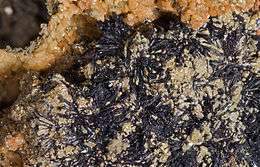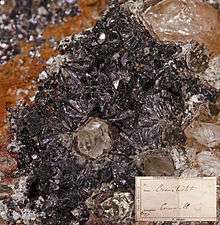Cronstedtite
Cronstedtite is a complex iron silicate mineral belonging to the serpentine group of minerals. It has a formula of Fe2+2Fe3+(Si,Fe3+O5)(OH)4.
| Cronstedtite | |
|---|---|
 Cronstedtite - Salsigne Mine - France | |
| General | |
| Category | Silicate minerals |
| Formula (repeating unit) | Fe2+2Fe3+(Si,Fe3+O5)(OH)4 |
| Strunz classification | 9.ED.15 |
| Crystal system | Trigonal |
| Crystal class | Ditrigonal pyramidal (3m) (same H-M symbol) |
| Space group | P31m |
| Unit cell | a = 5.486 Å, c = 7.095 Å; Z = 1[1] |
| Identification | |
| Color | Black, dark brown-black, green-black |
| Cleavage | Perfect on {001} |
| Tenacity | Elastic |
| Luster | Sub-Metallic |
| Streak | Dark olive green |
| Diaphaneity | Translucent |
| Specific gravity | 3.34 - 3.35 |
| Optical properties | Biaxial (-) |
| Refractive index | nα = 1.720 nβ = 1.800 nγ = 1.800 |
| Birefringence | δ = 0.080 |
| Pleochroism | Visible |
| Dispersion | r < v moderate |
| References | [1][2][3] |
It was discovered in 1821 and named in honor of Swedish mineralogist Axel Fredrik Cronstedt (1722–1765). It has been found in Bohemia in the Czech Republic and in Cornwall, England.
Cronstedtite is a major constituent of CM chondrites, a carbonaceous chondrite group exhibiting varying degrees of aqueous alteration. Cronstedtite abundance decreases with increasing alteration.[4]
References
| Wikimedia Commons has media related to Cronstedtite. |
- Webmineral.com
- Mindat.org
- American Mineralogical Society
- Browning et al. (1996) Geochimica et Cosmochimica Acta
This article is issued from Wikipedia. The text is licensed under Creative Commons - Attribution - Sharealike. Additional terms may apply for the media files.
